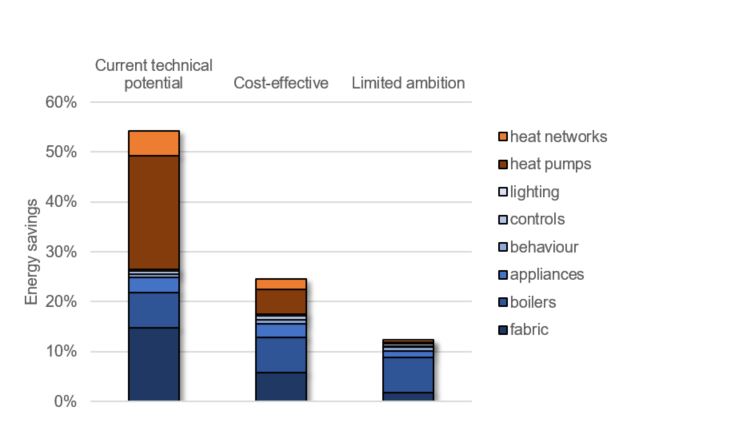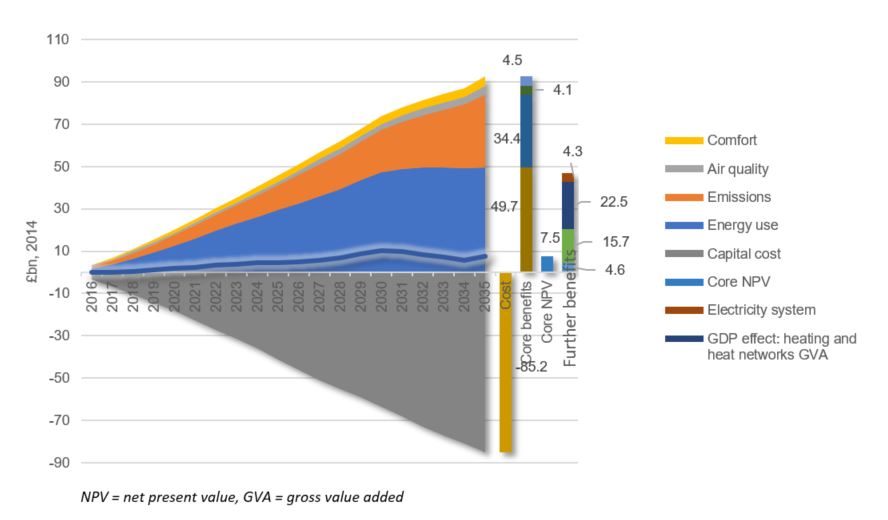“We have done all the easy stuff on energy efficiency,” Dr. Jan Rosenow was told during a 2016 workshop organised by the National Infrastructure Commission on the future of heat in the United Kingdom. Some participants felt that energy efficiency is just too difficult. It was after that workshop that a group of energy efficiency experts got together to answer a simple question: How much farther can energy efficiency go in the U.K.? Our response may surprise you.
Vast resource of untapped energy-saving opportunities
In an article published by Energy Policy, we answer this question by identifying a vast reservoir of untapped energy-saving opportunities in U.K. homes. Specifically, our estimates suggest that one-quarter of the energy currently used in U.K. households could be cost-effectively saved by 2035. This could even increase to half if allowance is made for falling technology costs and the wider benefits of energy efficiency improvements.

Our analysis utilises the Committee on Climate Change’s “central scenario,” which estimates the technologies and behaviours necessary to meet the U.K. carbon budgets cost-effectively. We also include estimates for the deployment of different technologies in households between now and 2035, with the associated energy and carbon savings. The data presented above show three scenarios representing progressively more ambitious levels of technology deployment:
- Limited ambition scenario: This includes all energy efficiency measures where the energy cost savings exceed the associated capital costs.
- Cost-effective scenario: This includes all energy efficiency measures that are estimated to be cost-effective according to criteria the U.K. government uses to appraise public policies and projects. In addition to accounting for energy cost savings, this approach places a monetary value on improvements in comfort and air quality and reductions in carbon emissions.
- Current technical potential scenario: This includes all measures currently available and applicable to today’s housing stock—without regard to their cost effectiveness.
The “layer cake” of benefits from energy efficiency
Energy efficiency improvements in residential buildings can deliver a wide range of benefits, or a “layer cake of benefits,” a term coined by the Regulatory Assistance Project. In our study, we estimated the present costs of the measures deployed in the “cost-effective” scenario, along with the present value of the associated benefits in the form of energy savings, emissions reductions, and improvements in comfort and air quality. Taken together, we estimate the net benefits of this scenario climb as high as £7.5 billion.
Thus, policy support is essential if the U.K. is to deliver on the full, cost-effective potential for energy efficiency.
Energy cost savings account for 54 percent of the benefits in this scenario, with the broad social benefits accounting for the remainder. Hence, the value placed upon those external benefits can significantly influence the assessed cost-effectiveness. Greenhouse gas savings account for 37 percent of the total benefits, while total air quality and comfort improvements account for less than 10 percent.

Our analysis shows that the energy cost savings alone won’t justify significant improvements in energy efficiency. Hence, the simplistic assumption that deployment can be left to the market because householders benefit from the energy savings is incorrect. That hypothesis doesn’t account for multiple obstacles, including financial and non-financial barriers. Thus, policy support is essential if the U.K. is to deliver on the full, cost-effective potential for energy efficiency.
Strengthening the Clean Growth Strategy
In its 2017 Clean Growth Strategy, the U.K. government set out a range of policies, proposals, and intentions to reduce U.K. carbon emissions and build a greener economy. But many of these proposals are lacking in either detail or ambition, and the “firm” policies announced are insufficient to deliver on the fourth and fifth carbon budgets.
For households, the strategy set out an aspiration to upgrade as many homes as possible to Energy Performance Certificate Grade C by 2035, provided this is “practical, cost effective and affordable.” With 19 million homes (70 percent) currently below this standard, achieving this aspiration would go a long way toward delivering not only the energy savings identified above, but also the associated private and social benefits. But much hinges on how the “cost effective and affordable” caveat is interpreted—and, in particular, whether the government recognises the broader social benefits of energy efficiency investments.
The ambitions set out in the Clean Growth Strategy need to be backed up with strong policies in a range of areas, including:
- An effective energy efficiency programme for the “able-to-pay” sector;
- More ambitious standards for private rented buildings;
- Regulations that ensure new buildings meet high standards of energy efficiency and are suitable for low-carbon heating; and
- Greater support for the deployment of heat pumps, particularly in dwellings that do not have access to natural gas.
Whilst energy efficiency might be challenging to deliver, it is clearly not “too difficult.” The best available evidence shows that upgrading the U.K.’s existing buildings can provide substantial energy savings while delivering large benefits to society. This strategy needs to be a principal component of the low-carbon energy transition.
A version of this blog originally appeared in Energy Post.
Photo credit: Duncan Kinney, Green Energy Futures

